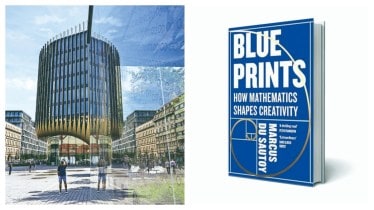By Shivaji Dasgupta
Rudyard Kipling would have been impressed by the unification of mathematics and creativity in Marcus Du Sautoy’s patently innovative,yet deeply rooted, narrative. For, it empowers us, rather simply, to blend scientific patterns and structures with spontaneous human creations — music, arts, architecture and more. In truth, lovingly curating a linear and symbiotic connection between the two unlikely bedfellows.
Make no mistake, the book is rooted in deep mathematics — Fibonacci numbers, fractals, platonic solids, hyperbolic geometry, prime numbers and their momentous peers — termed thoughtfully as ‘blueprints’. Over generations, this has been a source of much inspiration and, indeed, intimidation, for the creative community most certainly, who have been trained to believe that their craft resides in a flighty romantic universe, much removed from the chains of textbook rigour. This is a notion that the author is deeply motivated to dispel, through simple prose and decisive logic, as he argues most vehemently that these ‘blueprints’ are, indeed, secret sauces for artists, helping them connect meaningfully to audiences — in thought and emotion.
In terms of references, Du Sautoy does patent justice to the ages, drawing references from then and now, thereby building a compelling adhesive, including the earliest Stone Circles, Mozart’s penchant for numerics, new-age soundscapes by Radiohead and the inspirational architecture of Zaha Hadid. Rather audaciously, he suggests that creative mindsets are invaluable for mathematics and not just art, as they are fundamentally connected to the ‘natural’ world, by bonding with living at its truest and finest.
A firm foundation of the author’s work is the belief that creativity is indeed territorial currency for mathematicians, contrary to popular perception. He revels in the depiction of such folks as storytellers, no less accomplished than artists in terms of imaginative repertoire, thus clearly dismissing the notion that the Numbers Brigade is a soulless cadre, akin to KGB assassins on a do or die mission. Instead, he opines eloquently, that their craft is indeed as colourful as any other creative pursuit and this connectivity has been historically denied.
In a mirror hypothesis, the author suggests that many artists are blissfully unaware of the mathematical rooting in their work, and only a limited few view it as a pleasing inspiration. Extending this collective thought process to a civilisational world view, he believes that a conscious pooling of knowledge from both the domains will add richly to living at large – to address the ever expanding challenges of the 21st century, from conflict to calamity to community.
A collateral beauty of Du Satuoy’s work is his inclusive and attractive usage of language, designed to inspire and certainly not alienate, due to ‘domain’ gravitas. Thus equally, actually even more, compelling for practitioners of the arts, as they gingerly set foot in alien territory with preconceived hostilities. Yet it is never oversimplified, the due diligence to science diligently maintained as an able hub.
Rather remarkable in the thoughtful narrative is the exploration of randomness and disorder along with order and symmetry — as epitomised by art movements like Dadaism, which thrives on this duality. He also bravely suggests that mathematics and art have the power to go beyond what nature allows, as creativity can operate in tangible realities while numbers remain fodder for mind games.
In sum, Du Satuoy’s work is a masterful unification of mathematics and creativity, overturning the dubious dichotomy of logic versus emotion, in an analytical fashion. By defining the connections between hitherto conflicting civilisations, he attempts manfully to build a new sense of order. The book is most appropriately timed, in a world grappling with the perils and joys of artificial intelligence, in tantalising tandem.
Truthfully, this book can well be the United Nations of the Knowledge Universe, where mathematics and arts discover a palatable and empathetic forum to happily unite. To help co-create a meaningful world order where influences must necessarily merge to ensure the merry continuity of the human race. Indeed, a fresh perspective, which makes sense to both reason and rhyme.
The author is an autonomous brand consultant and writer
Blueprints: How Mathematics Shapes Creativity
Marcus du Sautoy
HarperCollins
Pp 304, Rs 599
